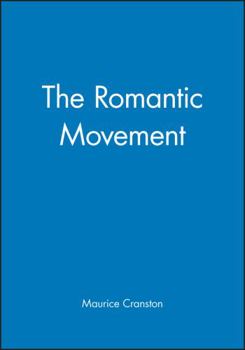The Romantic Movement: A Social and Cultural History
Select Format
Select Condition 
Book Overview
The Romantic Movement in Europe was both a revolt and a revival, a philosophy of life as well as of art. In the earliest expressions of romantic theory by Rousseau and Diderot, it is seen as a revolt against rationalism. In Great Britain and Italy it appears as a revolt against classicism, in Spain as a revival of the tradition of the Moorish courts, and in Germany, where it excited the greatest enthusiasm, as both a revolt against rationalism and a revival of the Gothic and Germanic. Despite the differences of aim and emphasis across Europe, Professor Cranston argues that romaticism was a European phenomenon, as universal as the Renaissance. He isolates its common features - liberty, introspection, and the importance of love; truth in the expression of feeling as much as of thought; nature seen as an object of devotion rather than scientific study; a tolerance of the grotesque coupled with an interest in the exotic, the primitive and the medieval; a concern for the value of intuition over ratiocination; and a preference for audacity over prudence. The Romantic Movement is part of the common European heritage, and its influence is by no means at an end. The book is the first to describe its philosophy, history, and cultural and artistic manifestations, and the ways these varied across the countries of Europe.
Format:Paperback
Language:English
ISBN:0631194711
ISBN13:9780631194712
Release Date:July 1994
Publisher:Wiley-Blackwell
Length:176 Pages
Weight:0.70 lbs.
Dimensions:0.5" x 6.0" x 9.0"
Customer Reviews
1 rating
Clear, concise, authoritative survey of the Romantic movement
Published by Thriftbooks.com User , 20 years ago
This slim volume (169 pages including bibliography and index) provides a concise, well-informed overview of the whole Romantic movement, embracing its influence in different fields (literature, art, philosophy, politics) and different countries (Germany, England, France, Italy, Spain). As a newcomer to Romanticism, I felt it met my needs admirably. Cranston's prose is simple, clear, and very readable. While I'm sure there are controversies and unresolved issues in scholarship about the Romantics, these are not presented here; nor are there any footnotes. Instead, writing with the directness and authority of one thoroughly familiar with his subject, Cranston just tells the story of Romanticism. His ability to outline the material so authoritatively suggests his depth of knowledge, without burdening the reader with excessive detail or supporting evidence. If you're new to the Romantic movement and would like to know what its main ideas were, who its key players were, and how its history unfolded, this book is close to ideal. If you're already a serious student of the Romantics, this book, I'm sure, would still provide a useful survey, especially in the country-by-country breakdown of its arrangement.






